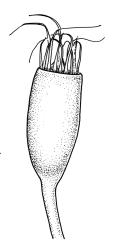The family Mitteniaceae includes only the genus Mittenia, which is, in turn, monotypic. Accordingly, the description of Mittenia plumula given below applies to both the family and its included genus.
The relationships of the Mitteniaceae have long been controversial. Brotherus (1924) placed the family in the order Bryales ("Eubryales"), suborder Rhizogoniineae with the Rhizogoniaceae, Calomniaceae, Sorapillaceae, and three other small families not occurring in N.Z.
The late Australian bryologist Ilma Stone studied the protonemal, gametophytic, and sporophytic morphology of Mittenia in meticulous detail (Stone 1961a; 1961b). She concluded (Stone 1961a) that the embryonic development of the Mittenia peristome is unique among the mosses for having an inner peristome derived from the outermost layer of the embryonic capsule (the amphithecium) and from the endothecium with "the wall between the two layers which contribute to the inner peristome [being] the original dividing wall between the embryonic amphithecium and endothecium". This development pattern contrasts to all others known to Stone in which both the endostome and exostome cell layers derive exclusively from amphithecial tissue.
Some years later she made a detailed comparison (Stone 1986) of the sporophyte development of Mittenia and the famed northern hemisphere genus Schistostega. She concluded that the similarities in protonemal morphology and "a lack of any strong contraindication to a relationship in capsule anatomy" indicate that Mittenia and the eperistomate Schistostega should be placed in one order (Schistostegales) but retained in separate monotypic families.
Other (mostly subsequently published) classifications have not accepted Stone’s proposed close relationship of the Mittenia and Schistostega. Shaw (1985) independently studied the Mittenia peristome and concluded (similarly to Stone) that it was neither haplolepideous nor diplolepideous and that "no other peristomial structure known in mosses … is homologous to the inner peristome of Mittenia". He therefore proposed a new order, the Mitteniales to accommodate this family with its single genus and species.
The classification used for the Flora of Australia (McCarthy 2006) places the Mitteniaceae in the Dicranales, while Goffinet et al. (2009) placed the family in the Pottiales, with the large and cosmopolitan family Pottiaceae and the monogeneric families Pleurophascaceae and Serpotortellaceae.
| Category | Number |
|---|---|
| Indigenous (Non-endemic) | 1 |
| Total | 1 |




